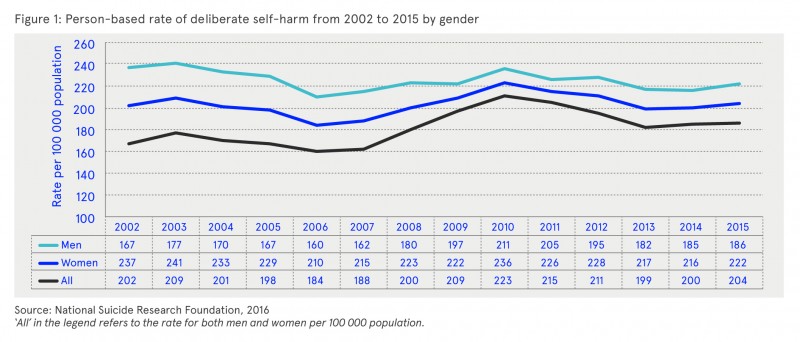Millar, Sean (2017) National Self-Harm Registry Ireland annual report, 2015. Drugnet Ireland, Issue 61, Spring 2017, p. 11.
| Preview | Title | Contact |
|---|---|---|
|
PDF (Drugnet Ireland 61)
518kB |
The 14th annual report from the National Self-Harm Registry Ireland was published in 2016.1 The report contains information relating to every recorded presentation of deliberate self-harm to acute hospital emergency departments in Ireland in 2015, and complete national coverage of cases treated. All individuals who were alive on admission to hospital following deliberate self-harm were included, along with the methods of deliberate self-harm that were used. Accidental overdoses of medication, street drugs or alcohol were not included.
Rates of self-harm
There were 11 189 recorded presentations of deliberate self-harm in 2015, involving 8791 individuals. This implies that more than one in five (21.4%) of presentations were repeat episodes. Taking the population into account, the age standardised rate of individuals presenting to hospital in the Republic of Ireland following self-harm was 204 per 100 000 population. This is similar to the rate recorded in 2014 (200 per 100 000). In recent years, there have been successive decreases in the self-harm rate between 2011 and 2013. Nevertheless, the rate in 2015 was still 9% higher than in 2007, the year before the start of the economic recession (Figure 1).

In 2015, the national male rate of self-harm was 186 per 100 000, 1% higher than in 2014. The female rate was 222 per 100 000, which was 3% higher than in 2014. Since 2007, male and female rates of self-harm have increased by 15% and 3%, respectively. With regard to age, when compared to 2014, the only significant change in the rate of hospital-treated self-harm was among men aged 35‒39 years, where the rate increased by 15% from 220 per 100 000 to 253 per 100 000. The authors noted that increasing rates observed in males is particularly worrying, considering the higher lethality of self-harm methods among men.
Self-harm and drug and alcohol use
Intentional drug overdose was the most common form of deliberate self-harm reported in 2015, occurring in 7319 (65%) of episodes. As observed in 2014, overdose rates were higher among women (71%) than among men (59%). A minor tranquilliser, paracetamol-containing medicines, and antidepressants/mood stabilisers were involved in 38%, 29% and 20% of drug overdose acts, respectively. In 69% of cases, the total number of tablets taken was known, with an average of 28 tablets taken in episodes of self-harm that involved a drug overdose.
There was an 18% increase in the number of presentations involving street drugs (cannabis, ecstasy and cocaine), which rose from 465 in 2014 to 547 in 2015 (following annual decreases from 2010 to 2013). The 2015 level is the highest recorded since 2008 and the second highest ever recorded by the registry. Alcohol was involved in 31% of all self-harm presentations, and was significantly more often involved in male episodes of self-harm than females. The authors reported that, as in previous years, alcohol continued to be one of the factors associated with the higher rate of self-harm presentations on Sundays, Mondays and public holidays, and in the hours around midnight.
The authors concluded that these findings underlined the need for ongoing efforts to:
- Reduce access to minor tranquilisers and other frequently used drugs.
- Conduct further research to examine the sources of illicit drugs used in intentional overdoses.
- Enhance health service capacity at specific times.
- Intensify national strategies to increase awareness of the risks involved in the use and misuse of alcohol.
- Develop further strategies to reduce access to alcohol.
The report highlighted the ongoing work by the National Suicide Research Foundation to link data on deliberate self-harm with suicide mortality data. This linking has shown that individuals who self-harm are over 42 times more likely to die by suicide than the general population. Further linkage is recommended in order to enhance insight into predictors of suicide risk.
1 Griffin E, Arensman E, Dillon CB, Corcoran P, Williamson E and Perry IJ (2016). National Self-Harm Registry Ireland annual report 2015. Cork: National Suicide Research Foundation. https://www.drugsandalcohol.ie/26297/
F Concepts in psychology > Behaviour > Self-destructive behaviour / self-harm > Suicidal behaviour / suicide
P Demography, epidemiology, and history > Population dynamics > Substance related mortality / death
VA Geographic area > Europe > Ireland
Repository Staff Only: item control page